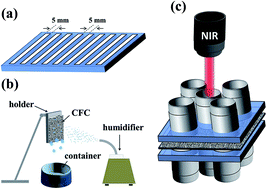Biomimetic structure of carbon fiber cloth grafted with poly(N-isopropylacrylamide) for water collection and smart gates†
Abstract
An eco-friendly, facile, and efficient method was developed to modify carbon fiber cloth (CFC) having superhydrophobic or hydrophilic properties. The method used polydopamine (PD) as a mediating layer, followed by grafting titanium oxide and poly(N-isopropylacrylamide) (PNIPAM) through mussel adhesion protein-inspired surface chemistry. Carbon fiber cloth with periodic superhydrophobic–hydrophilic patterns was fabricated and its ability for water collection from moisture generated by a humidifier was determined. The patterned CFC exhibited excellent performance in water collection with an efficiency of 206 mg cm−2 h−1, far higher than those of uniform hydrophilic and superhydrophobic surfaces. The carbon fiber cloth grafted with PNIPAM also possesses thermo-responsive properties and swelled dramatically during its volume-phase transition. This study demonstrated that the water permeability of PNIPAM-grafted CFC could be controlled remotely by near infrared laser irradiation. Together, we believe that the modified CFC shows high potential to be used for smart clothes and collecting water from air, and serves as a smart valve in controlling fluid flow for applications in bioreactors and microfluidic systems.



 Please wait while we load your content...
Please wait while we load your content...